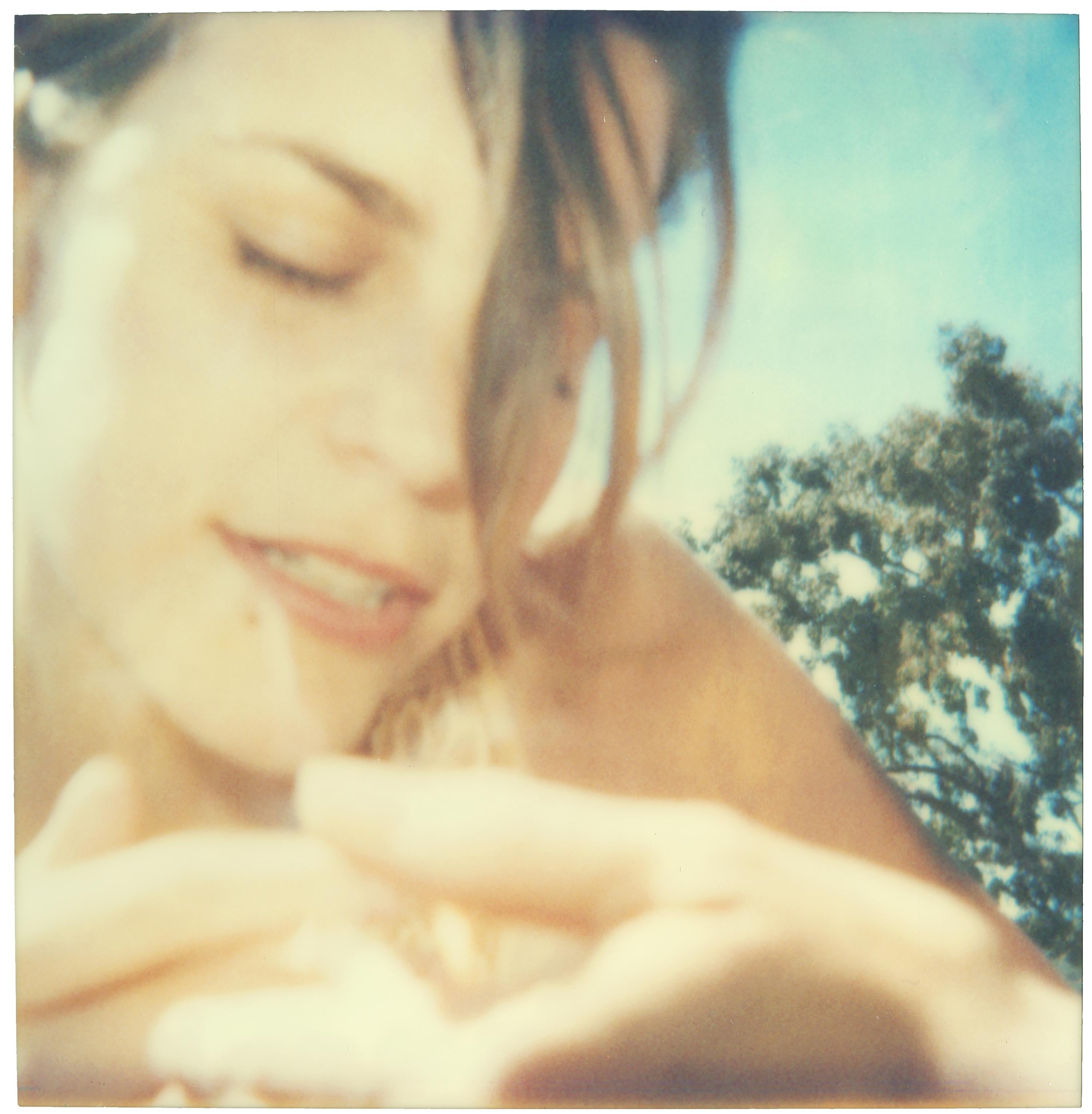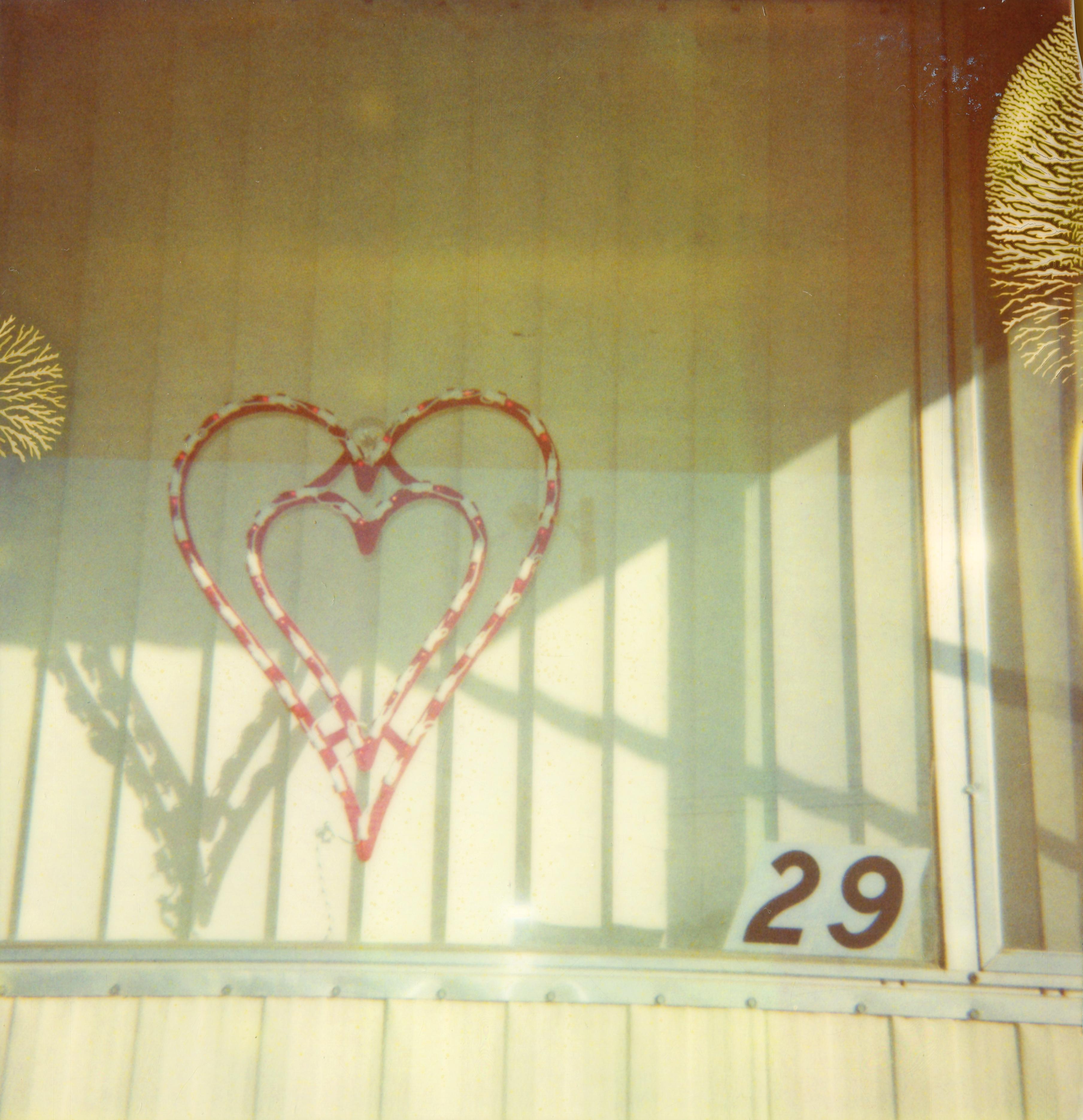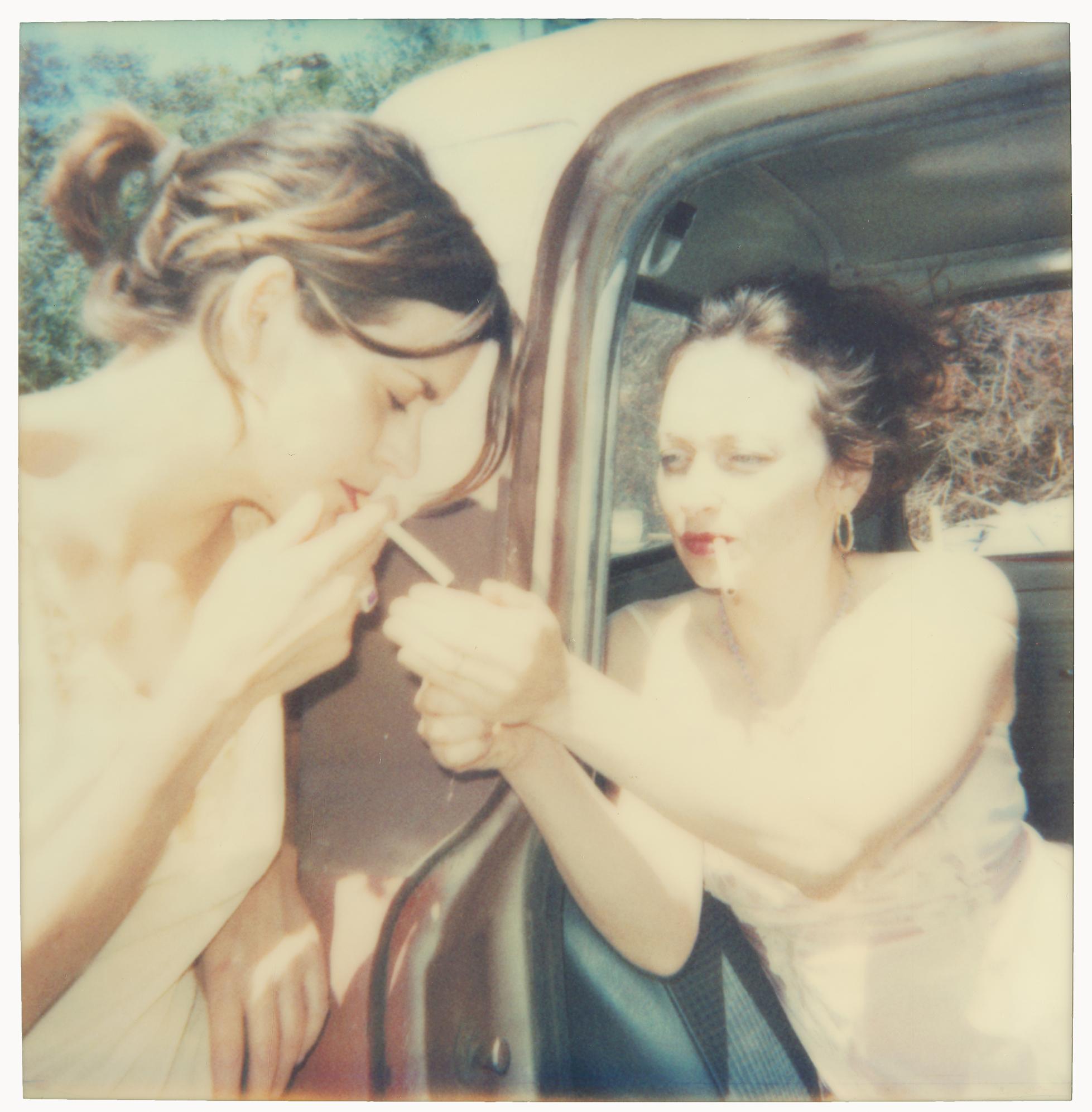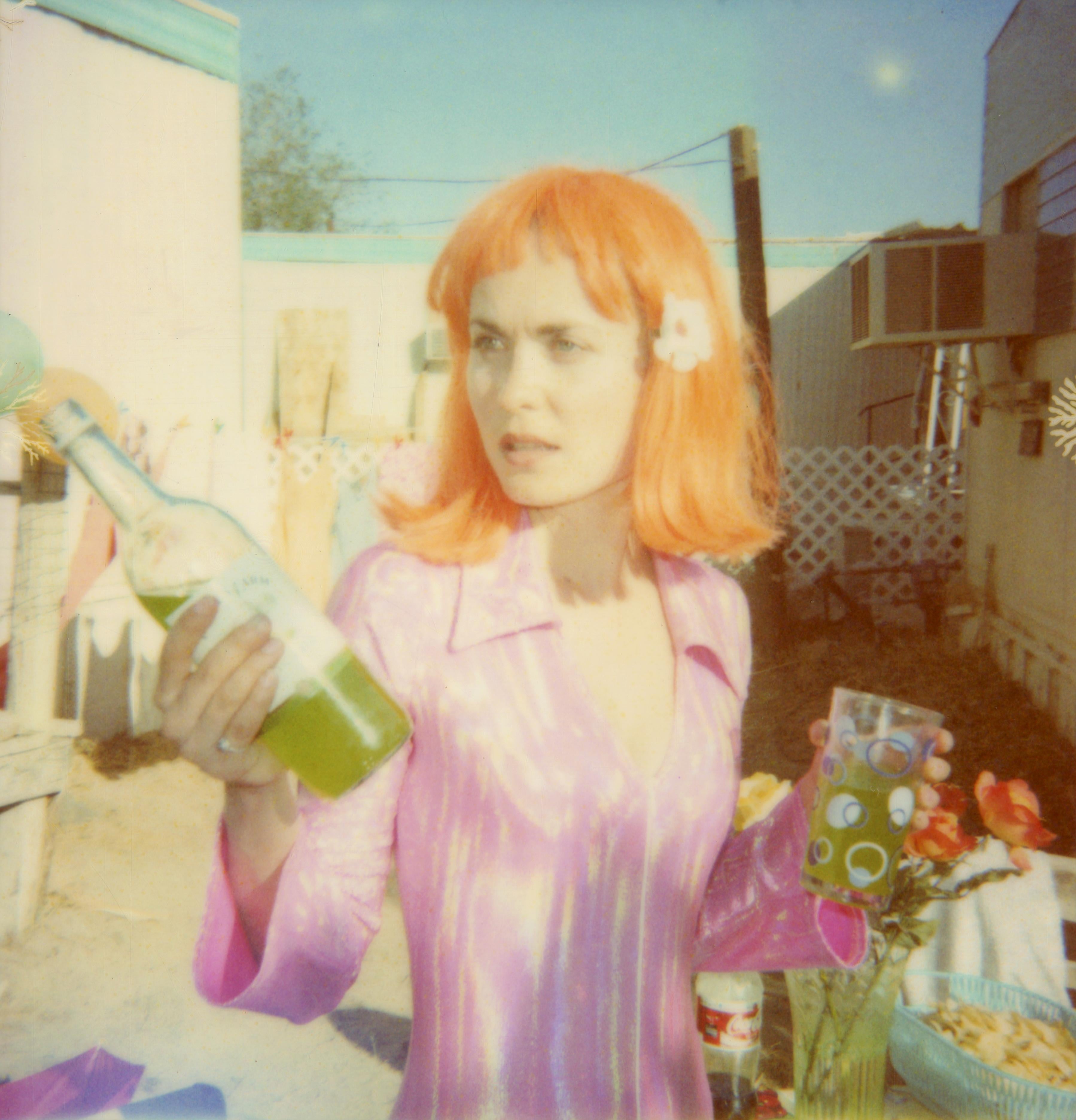Items Similar to Preppers - Heavenly Falls
Want more images or videos?
Request additional images or videos from the seller
1 of 5
Stefanie SchneiderPreppers - Heavenly Falls2016
2016
About the Item
'Preppers' (Heavenly Falls) 2016,
50x60cm, Edition 2/10,
Lambda Print based on a Polaroid
Certificate and signature label
artist inventory number: 19678.02
Not mounted.
Stefanie Schneider interviewed for Instant Dreams Documentary coming out Dec 14th 2017 in Europe and Jan 8th 2018 in USA
When did you first decide to work with Polaroids? Why do Polaroids seem to be so well tuned to our (artistic) senses, perception and minds?
I started using expired Polaroid film in 1996. It has the most beautiful quality and encapsulates my vision perfectly. The colors on one hand, but then the magic moment of witnessing the image appear. Time seems to stand still, and the act of watching the image develop can be shared with the people around you. It captures a moment, which becomes the past so instantly that the decay of time is even more apparent; – it gives the image a certain sentimentality. The Polaroid moment is an original every time.
Why use a medium from the past?
For me, analog has always been there in the present. For the new generation, analog is interesting because it's new to them. I understand that people growing up in a digital age will wonder about its usefulness, but it's theirs to recover if they want to. When I first started working with Polaroid, it wasn't the past. It was a partially forgotten medium, but it existed nonetheless. It is mine by choice. There is no substitute for tangible beauty.
Is it imperfect?
The imperfect perfection in a “wabi-sabi” kind of way.
Wabi-sabi (侘寂) represents a comprehensive Japanese world view or aesthetic centered on the acceptance of transience and imperfection. The aesthetic is sometimes described as one of beauty that is imperfect, impermanent, and incomplete.
'If an object or expression can bring about, within us, a sense of serene melancholy and a spiritual longing, then that object could be said to be wabi-sabi'. 'Wabi-sabi nurtures all that is authentic by acknowledging three simple realities: nothing lasts, nothing is finished, and nothing is perfect.'
Is the Polaroid photograph recognizable or even sometimes cliché?
Absolutely! There's something cliché about the way I'm showing the American Dream. I live it myself, trying to find perfection in an imperfect world. Reaching for the horizon. The dream is broken; the cliché tumbles. There are different ways to involve an audience. You could make movies like Harmony Korine's 'Gummo' a masterpiece in my view, which would estrange a large part of the audience. A certain film education is a prerequisite. Or you can start with clichés, the audience then feels safe, which lures them into the depth of your world without them even knowing it or understanding where exactly they are being led to. Appealing to emotions and the sub-conscious. Normal, Change, New Normal.
You continually revisit the landscape of the American West in your work. What draws you back to this scene?
Southern California represents a dream to me. The contrast of Northern Germany, where I grew up, to the endless sunshine of Los Angeles was what first attracted me. The American West is my dream of choice. Wide, open spaces give perspectives that articulate emotions and desires. Isolation feeds feelings of freedom or sometimes the pondering of your past. The High Desert of 29 Palms has very clear and vivid light, which is vital. Expired Polaroid film produces 'imperfections' that I would argue mirrors the decline of the American dream. These so called 'imperfections' illustrate the reality of that dream turning into a nightmare. The disintegration of Western society.
Are you playing with the temporality of the material and the value of the moment itself?
The value of the moment is paramount, for it is that moment that you're trying to transform. All material is temporary, it's relative, and time is forever.
Why does analog film feel more pure and intuitive?
It's tangible and bright and represents a single moment.
The digital moment may stay in the box (the hard drive / camera / computer etc.) forever, never to be touched, put into a photo album, sent in a letter, or hung on a wall. Printing makes it an accomplishment.
The analog world is more selective, creating images of our collective memory.
The digital worldwide clicking destroys this moment. The generation without memories due to information overload and hard drive failures. Photo albums are a thing of the past.
Why does it feel this way?
That's how the human instinct works.
When I was a child, every picture been taken was a special moment. Analog photographic film as well as Super-8 material were expensive treasures. My family's memories were created by choosing certain moments in time. There was an effort behind the picture. The roll of film might wait months inside the camera before it was all used. From there, the film required developing, which took more time, and finally, when the photos were picked up from the shop, the memories were visited again together as a family. Who knew then, how fleeting these times were. Shared memories was a ritual.
What's your philosophy behind the art of Polaroid pictures?
The 'obsolete' is anything but obsolete. Things are not always as they appear, and there are hidden messages. Our memories and our dreams are under-valued. It is there that real learning and understanding begins by opening yourself to different perspectives.
What inspired you to use stop motion cinematography?
My work has always resembled movie stills. I remember the first time I brought a box of Polaroids and slid them onto Susanne Vielmetter's desk (my first gallery). Instantly, it became apparent that there was a story to tell. The stories grew. It was undeniable to me, that the emerging story was where I was destined to go. I've made four short films before my latest feature film, "The Girl behind the White Picket Fence". This film is 60 minutes long with over 4000 edited Polaroids. It's important to remember that our sub-conscious fills in the blanks, the parts missing from the story allow a deeper and more personal experience for the viewer. That is, if you surrender yourself and trust me as the director to lead you somewhere you might not have been before.
Why do you think it is important to own art?
'We have art in order not to die of the truth' Nietzsche
Interview published in Stefanie's Schneider our catalog.
A German view of the American West
The works of Stefanie Schneider evoke Ed Ruscha's obsession with the American experience, the richness of Georgia O'Keefe's deserts and the loneliness of Edward Hopper's haunting paintings. So how exactly did this German photographer become one of the most important artists of the American narrative of the 20th and 21st century?
This theme of preservation and deterioration is a core part of Schneider's oeuvre. In an interview in October 2014 with Artnet, the artist explained how her own experiences of pain and loss inspire her. ''My work resembles my life: Love, lost and unrequited, leaves its mark in our lives as a senseless pain that has no place in the present.'' The first to use expired Polaroid film as their medium and in doing so inspired the resurrection of Polaroid film itself. Saving the last production line in the world from it's impending destruction in 2008.
Schneider's subjects are often featured in apocalyptic settings: desert planes, trailer parks, oilfields, run-down motels and empty beaches, alone, or if not, not connected with one another. ''It is the tangible experience of ''absence'' that has inspired my work,'' explained Schneider.
(Barnebys UK, May 3, 2017
Stefanie Schneider received her MFA in Communication Design at the Folkwang Schule Essen, Germany. Her work has been shown at the Museum for Photography, Braunschweig, Museum für Kommunikation, Berlin, the Institut für Neue Medien, Frankfurt, the Nassauischer Kunstverein, Wiesbaden, Kunstverein Bielefeld, Museum für Moderne Kunst Passau, Les Rencontres d'Arles, Foto -Triennale Esslingen, Bombay Beach Biennale 2018.
- Creator:Stefanie Schneider (1968, German)
- Creation Year:2016
- Dimensions:Height: 19.69 in (50 cm)Width: 23.63 in (60 cm)Depth: 0.04 in (1 mm)
- More Editions & Sizes:20x24cmPrice: $200
- Medium:
- Movement & Style:
- Period:
- Condition:new.
- Gallery Location:Morongo Valley, CA
- Reference Number:1stDibs: LU652310307722
About the Seller
4.9
Platinum Seller
These expertly vetted sellers are 1stDibs' most experienced sellers and are rated highest by our customers.
Established in 1996
1stDibs seller since 2017
953 sales on 1stDibs
Typical response time: 2 hours
- ShippingRetrieving quote...Ships From: Morongo Valley, CA
- Return PolicyA return for this item may be initiated within 7 days of delivery.
More From This SellerView All
- Untitled (Cathy and Shannon) - Contemporary, 21st Century, PolaroidBy Stefanie SchneiderLocated in Morongo Valley, CAUntitled (Cathy and Shannon) - 2004 20x20cm, Edition of 10, plus 2 Artist Proofs. Archival C-Print, based on a Polaroid. Certificate and Signature label. Artist Inventory No. 481...Category
Early 2000s Contemporary Color Photography
MaterialsArchival Paper, Photographic Paper, C Print, Color, Polaroid
- Home, sweet 29 (Oxana's 30th Birthday) - part of the 29 Palms, CA projectBy Stefanie SchneiderLocated in Morongo Valley, CAHome, sweet 29 (Oxana's 30th Birthday) - part of the 29 Palms, CA project - 2007 Edition of 5 plus 2 Artist Proofs, 58x56cm. Analog C-Print, hand-printed by the artist, based on...Category
Early 2000s Contemporary Portrait Photography
MaterialsArchival Paper, Photographic Paper, C Print, Color, Polaroid
- Untitled (Cathy and Shannon) - Contemporary, 21st Century, PolaroidBy Stefanie SchneiderLocated in Morongo Valley, CAUntitled (Cathy and Shannon) - 2004 20x20cm, Edition of 10, plus 2 Artist Proofs. Archival C-Print, based on a Polaroid. Certificate and Signature label. Artist Inventory No. 480...Category
Early 2000s Contemporary Color Photography
MaterialsColor, Polaroid, Archival Paper, Photographic Paper, C Print
- Untitled (Cathy and Shannon) - Contemporary, 21st Century, PolaroidBy Stefanie SchneiderLocated in Morongo Valley, CAUntitled (Cathy and Shannon) - 2004 20x20cm, Edition of 10, plus 2 Artist Proofs. Archival C-Print, based on a Polaroid. Certificate and Signature label. Artist Inventory No. 490...Category
Early 2000s Contemporary Color Photography
MaterialsArchival Paper, Photographic Paper, C Print, Color, Polaroid
- 'Looking back' (Till Death do us Part) - 21st Century, Polaroid, ContemporaryBy Stefanie SchneiderLocated in Morongo Valley, CALooking back (Till Death do us Part) - 2005, 50x50cm, Edition of 10, digital C-Print print, based on a Polaroid, Certificate and Signature label, artist Inventory No. 9485, Not ...Category
Early 2000s Contemporary Portrait Photography
MaterialsArchival Paper, Photographic Paper, C Print, Color, Polaroid
- American Pie (Oxana's 30th Birthday) starring Radha Mitchell - PolaroidBy Stefanie SchneiderLocated in Morongo Valley, CAAmerican Pie (Oxana's 30th Birthday) -2007, from the 29 Palms, CA project - 38x36cm, Edition of 10. digital C-Print print, based on a Polaroid, mounted...Category
Early 2000s Contemporary Portrait Photography
MaterialsColor, Polaroid, Plexiglass, Archival Paper, Photographic Paper, C Print
You May Also Like
- Private ViewsBy Barbara CraneLocated in Saint Louis, MOBarbara Crane Private Views, 1980-4 Polaroid type 59 Framed Dimensions: 14 1/4 x 12 1/4 inches (36.2 x 31.1 cm) Image Dimensions: 4 1/2 x 5 1/5 inches (11.4 x 13.2 cm) Edition 1/1Category
Late 20th Century Contemporary Color Photography
MaterialsPolaroid
- Channel Swimmers, July 15, 1984By Neal SlavinLocated in Dallas, TXUnique polaroid. Signed, titled, and dated in pencil on print verso by Neal Slavin. Paper size: 30 x 22 in. Image size: 24 x 20 in. 32 1/2 x 29 1/4 x 2 in. white frame included. Nea...Category
20th Century Contemporary Portrait Photography
MaterialsPolaroid
- Elena SeatedBy Jack PernoLocated in Chicago, ILArchival Pigment Print Edition of 25 Print size: 38 H x 30 W inches Frame size: 54 H x 44 W inches This piece is a digital reproduction of an original 8 x 10" polaroid that was man...Category
21st Century and Contemporary Contemporary Color Photography
MaterialsInkjet, Polaroid, Archival Ink, Archival Paper
- Elena WashingBy Jack PernoLocated in Chicago, ILArchival Pigment Print Edition of 25 Print size: 38 H x 30 W inches Frame size: 54 H x 44 W inches This piece is a digital reproduction of an original 8 x 10" polaroid that was man...Category
21st Century and Contemporary Contemporary Color Photography
MaterialsArchival Ink, Archival Paper, Inkjet, Polaroid
- Channel Swimmers, July 15, 1984 by Neal Slavin, 1984, Unique Polaroid PrintBy Neal SlavinLocated in Dallas, TXChannel Swimmers by Neal Slavin depicts an eclectic group posed by a red life buoy on a pebble beach. The group is dressed in swimming attire, all with varying colors and styles of g...Category
20th Century Contemporary Portrait Photography
MaterialsPolaroid
- Untitled, from the series 'Cui Cui' – Rinko Kawauchi, Self-portrait, PhotographyBy Rinko KawauchiLocated in Zurich, CHRINKO KAWAUCHI (*1972, Japan) Untitled, from the series 'Cui Cui' 2005 C–type print Sheet 30,5 x 25,4 cm (12 x 10 in.) Frame 31,5 x 26,5 x 2,5 cm Edition of 6; Ed. no. 4/6 Kawauchi,...Category
2010s Contemporary Color Photography
MaterialsC Print





